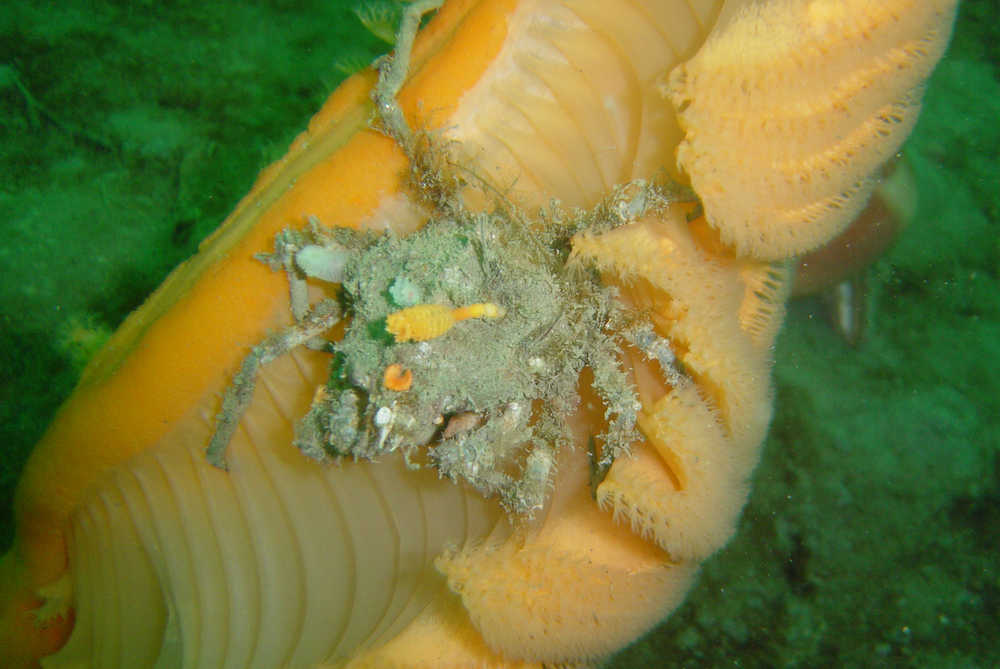Animals hide themselves from visual searchers in many ways. Some hide in plain sight with camouflage (snowshoe hares, rattlesnakes). Some remove themselves from view in burrows or thick vegetation (mice, nesting puffins). Still others “hide” behind a threat (coral snakes and bumblebees, which have warning coloration).
In addition, there are lots of animals that disguise themselves by adding extraneous material from the environment to themselves. Among the best-known examples are the many species of spider crabs that “decorate” their backs (and sometimes heads, claws, legs too) with snipped off bits of coral, anemones, algae, sponges, hydroids, shells and whatnot. Some of these decorator crabs are very fussy about their décor, using only a single sort of decoration, while others have wider tastes. The decorations are attached to the crab’s carapace by special velcro-like hooks.
In most cases, the decorations probably function chiefly as protection from predators, and juvenile crabs reportedly do more decorating than the larger, less vulnerable adults, but good experiments are few. In a few species, the decorations may also be a handy pantry for snack or provide some chemical protection (from distasteful algae) in addition to visual camouflage. There can be a cost to carrying a load of decoration, however, because of the energy needed to transport the useful baggage and locomotion might be slowed.
Among the many kinds of spider crabs is a group known as the kelp crabs. A nice experimental and comparative study of three kelp crab species showed that the least decorated species showed the greatest ability to change color, and the most decorated species had the least capacity for color change. In both cases, the favored type of concealment provided better protection from predators than the other type of concealment.
Still other disguising crabs are found in several taxonomic families (not part of the spider crab complex). These are the carrying crabs, which use their modified fifth (and sometimes fourth) legs to lift up and hold objects over the crab’s back. The big claws in front may be used to cut pieces of algae, sponge, or tunicate (a marine invertebrate), but the other legs are then used to hold the object in position. Other carried objects include mollusc shells, bits of rock, a piece of a sea fan or coral, or even (in one case) a fish head. Carrying behavior is thought to be a form of camouflage in most cases, but sponges and tunicates, which are distasteful to many predators, may offer some chemical protection, too.
The world of insects offers many fine examples of disguise, as well. Here are just a few, fortunately supported by tidy scientific experiments. Certain assassin bugs in Africa prey on ants and are themselves potential prey for spiders and geckos. Juvenile assassin bugs put the carcasses of sucked-dry, dead ants on their backs, where the empty husks are held by fine threads secreted by the bug. In effect, it’s a backpack made of trash. The trashy backpacks turn out to be effective in deterring attacks by spiders and geckos. When the backpacks were removed by experimenting scientists, the bugs were captured by the predators more often than those with intact backpacks. Apparently the trash-carrying bugs just didn’t look like bugs, so they were attacked less often; but if they did get attacked, the predator often just got the trash, while the bug scuttled away.
Similarly, trash-carrying green lacewing larvae in Japan put carcasses of their aphid prey on their backs and derive protection from ladybird predators. Again, the trash-carrying lacewing larvae are both more difficult to detect and to capture than larvae without a load of trash.
A little closer to home, the larvae of another green lacewing in North America prey on woolly aphids that cover their bodies with a tangle of waxy filaments that look like wool. The lacewing larvae collect the woolly material from aphids to place on their own backs. The lacewing larvae thus become visually, and possibly chemically, much like their prey. The aphid colonies are commonly tended and protected by ants that feed on “honeydew” from the aphids and attack anything that threatens the ants’ aphids. Experiments clearly showed that the disguised lacewing larvae were seldom attacked by the guardian ants and so had ready access to their aphid prey.
The list goes on — there’s another lacewing whose larvae collect many little branched hairs from the undersides of sycamore leaves and make a backpack that protects them against ants and carnivorous bugs; it takes the equivalent of two sycamore leaves to make a complete backpack. The larvae of yet another lacewing cover themselves with bits of lichen. And the Florida tortoise beetle larvae recycle their own feces, making a thatch that covers the body and deters many predators (but not all … a certain predatory beetle is undeterred).
• Mary F. Willson is a retired professor of ecology.

